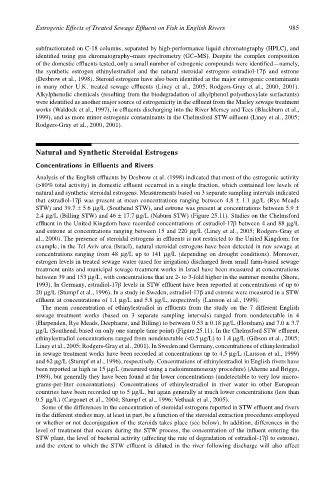Page 1005 - The Toxicology of Fishes
P. 1005
Estrogenic Effects of Treated Sewage Effluent on Fish in English Rivers 985
subfractionated on C-18 columns, separated by high-performance liquid chromatography (HPLC), and
identified using gas chromatography–mass spectrometry (GC–MS). Despite the complex composition
of the domestic effluents tested, only a small number of estrogenic compounds were identified—namely,
the synthetic estrogen ethinylestradiol and the natural steroidal estrogens estradiol-17β and estrone
(Desbrow et al., 1998). Steroid estrogens have also been identified as the major estrogenic contaminants
in many other U.K. treated sewage effluents (Liney et al., 2005; Rodgers-Gray et al., 2000, 2001).
Alkylphenolic chemicals (resulting from the biodegradation of alkylphenol polyethoxylate surfactants)
were identified as another major source of estrogenicity in the effluent from the Marley sewage treatment
works (Waldock et al., 1997), in effluents discharging into the River Mersey and Tees (Blackburn et al.,
1999), and as more minor estrogenic contaminants in the Chelmsford STW effluent (Liney et al., 2005;
Rodgers-Gray et al., 2000, 2001).
Natural and Synthetic Steroidal Estrogens
Concentrations in Effluents and Rivers
Analysis of the English effluents by Desbrow et al. (1998) indicated that most of the estrogenic activity
(>80% total activity) in domestic effluent occurred in a single fraction, which contained low levels of
natural and synthetic steroidal estrogens. Measurements based on 3 separate sampling intervals indicated
that estradiol-17β was present at mean concentrations ranging between 4.8 ± 1.1 µg/L (Rye Meads
STW) and 39.7 ± 5.6 µg/L (Southend STW), and estrone was present at concentrations between 5.9 ±
2.4 µg/L (Billing STW) and 46 ± 17.7 µg/L (Naburn STW) (Figure 25.11). Studies on the Chelmsford
effluent in the United Kingdom have recorded concentrations of estradiol-17β between 4 and 88 µg/L
and estrone at concentrations ranging between 15 and 220 µg/L (Liney et al., 2005; Rodgers-Gray et
al., 2000). The presence of steroidal estrogens in effluents is not restricted to the United Kingdom; for
example, in the Tel Aviv area (Israel), natural steroidal estrogens have been detected in raw sewage at
concentrations ranging from 48 µg/L up to 141 µg/L (depending on drought conditions). Moreover,
estrogen levels in treated sewage water (used for irrigation) discharged from small farm-based sewage
treatment units and municipal sewage treatment works in Israel have been measured at concentrations
between 39 and 153 µg/L, with concentrations that are 2- to 3-fold higher in the summer months (Shore,
1993). In Germany, estradiol-17β levels in STW effluent have been reported at concentrations of up to
20 µg/L (Stumpf et al., 1996). In a study in Sweden, estradiol-17β and estrone were measured in a STW
effluent at concentrations of 1.1 µg/L and 5.8 µg/L, respectively (Larsson et al., 1999).
The mean concentration of ethinylestradiol in effluents from the study on the 7 different English
sewage treatment works (based on 3 separate sampling intervals) ranged from nondetectable in 4
(Harpenden, Rye Meads, Deephams, and Billing) to between 0.53 ± 0.18 µg/L (Horsham) and 7.0 ± 3.7
µg/L (Southend, based on only one sample time point) (Figure 25.11). In the Chelmsford STW effluent,
ethinylestradiol concentrations ranged from nondetectable (<0.5 µg/L) to 1.4 µg/L (Gibson et al., 2005;
Liney et al., 2005; Rodgers-Gray et al., 2001). In Sweden and Germany, concentrations of ethinylestradiol
in sewage treatment works have been recorded at concentrations up to 4.5 µg/L (Larsson et al., 1999)
and 62 µg/L (Stumpf et al., 1996), respectively. Concentrations of ethinylestradiol in English rivers have
been reported as high as 15 µg/L (measured using a radioimmunoassay procedure) (Aherne and Briggs,
1989), but generally they have been found at far lower concentrations (undetectable to very low micro-
grams-per-liter concentrations). Concentrations of ethinylestradiol in river water in other European
countries have been recorded up to 5 µg/L, but again generally at much lower concentrations (less than
0.5 µg/L) (Cargouet et al., 2004; Stumpf et al., 1996; Vethaak et al., 2005).
Some of the differences in the concentration of steroidal estrogens reported in STW effluent and rivers
in the different studies may, at least in part, be a function of the steroidal extraction procedures employed
or whether or not deconjugation of the steroids takes place (see below). In addition, differences in the
level of treatment that occurs during the STW process, the concentration of the influent entering the
STW plant, the level of bacterial activity (affecting the rate of degradation of estradiol-17β to estrone),
and the extent to which the STW effluent is diluted in the river following discharge will also affect

